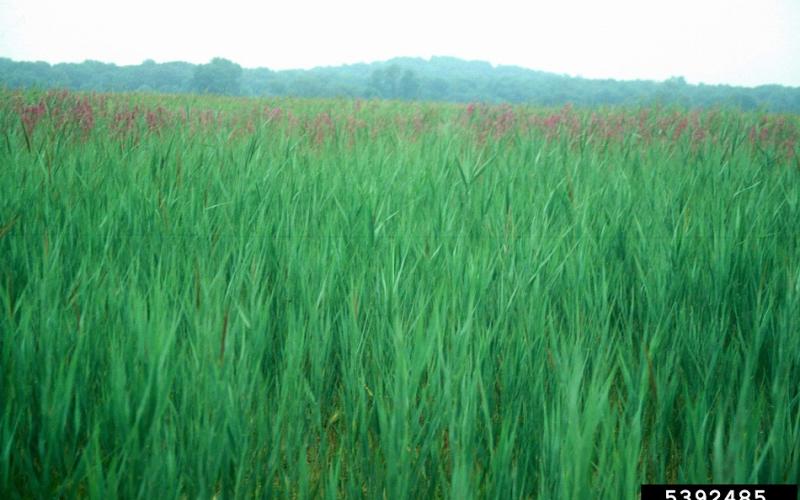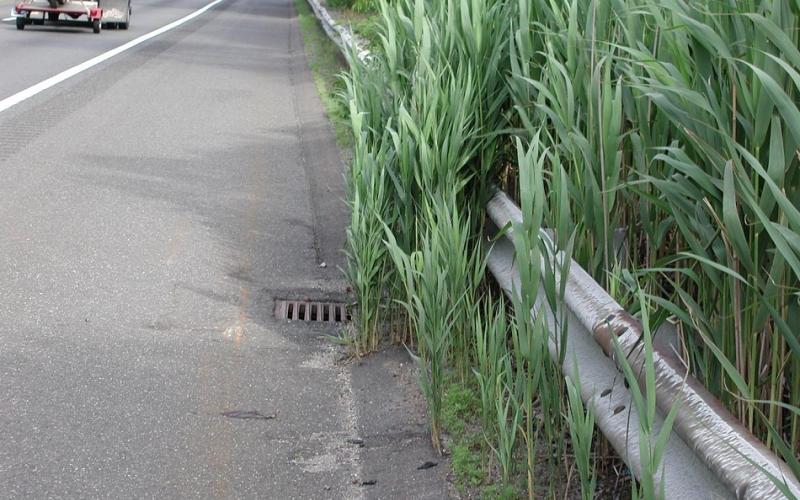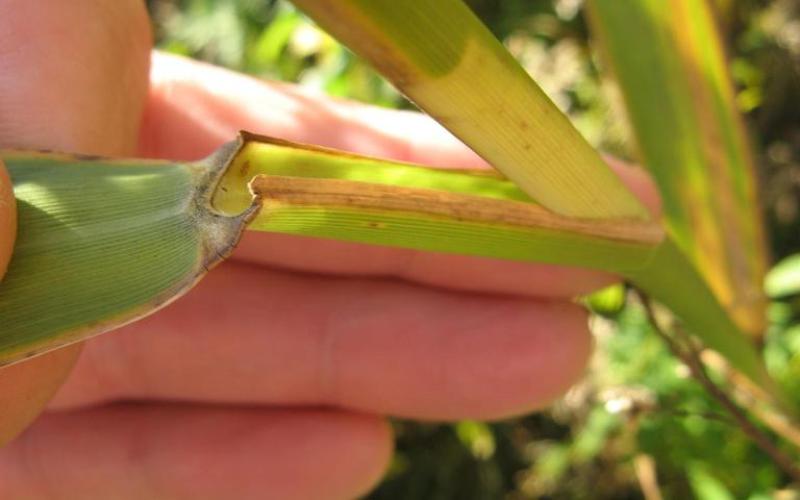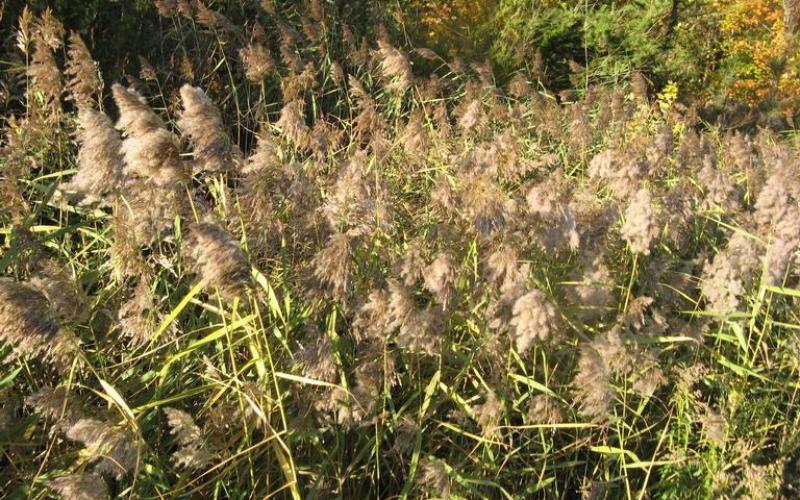Common Name: Non-native Phragmites
Alternate Names: Invasive giant reed, invasive giant reedgrass, invasive Phragmites
Scientific Name: Phragmites australis subspecies australis (Cav.) Trin. ex Steud.
Similar Species: Native common reed - Phragmites australis (Cav.) Trin. ex Steud.
Legal Status
Efforts must be made to prevent seed maturation and dispersal of plants into new areas. Additionally, no transportation, propagation, or sale of these plants is allowed. Failure to comply may result in enforcement action by the county or local municipality.
Waste water treatment facilities (WWTF) with established reed beds prior to February 1, 2021, that are adhering to state approved best management practices for facilities and transporting biosolids, with the ultimate goal of enacting a phase out of non-native Phragmites if alternative wastewater treatment options can be found, are exempt from controlling non-native Phragmites in the reed beds.
WWTF should contact their County Ag Inspector to obtain a transport permit.
Background
There are two varieties of Phragmites australis in Minnesota. The first is the variety native to North America that is not invasive. The second is an introduced variety (subspecies australis - A.K.A. invasive common reed) that has been shown to be very aggressive and is responsible for displacing populations of native common reed throughout the United States, including Minnesota. This semi-aquatic perennial grass species was first introduced to North America in the 1700s or early 1800s along the eastern seaboard. Over the course of the 20th century, it has spread across the entire continent, invading wetlands, lake shores, streambanks and marshy areas. Both the native and invasive varieties look similar and it takes some familiarity to learn the differences between both plants.
Description
- A warm season, perennial, semi-aquatic grass species that can reach heights of up to 15 feet and forms dense clonal stands containing both living and dead shoots from previous growing seasons.
- Stems are hollow, ridged, and rough in texture, lack fungal spots and red internodes (common on native variety stems), are green with yellow nodes during the growing season and tan/yellow when dry during the winter.
- Leaves are blue-green, 15 - 20 inches long, 1 - 1.5 inches wide, and are arranged all along one side of the stem. Leaves adhere tightly to the stem throughout the growing season and remain as long as the stalk stays standing.
- Flowers develop in early August at the tip of each stem and form dense feathery panicles that are typically purple (early development) to golden (late season/winter) in color.
- Flowering stalks produce thousands of grayish seeds covered in fine silky hairs that give them a fluffy appearance.
- Below ground, root growth is extensive. Roots and rhizomes can spread more than 10 feet laterally and several feet deep during a single growing season.
- It is IMPORTANT that the differences between the native species and non-native subspecies are clearly identified before deeming a site infested by invasive common reed. There are many online resources available that provide comparisons of both plants. Please visit the National Park Service's Plant Conservation Alliance's web page or Michigan State University Extension information to learn the differences.
Habitat
Non-native phragmites can be found in a variety of aquatic to semi-aquatic habitats throughout the state. This plant is more likely to be found in disturbed sites where soil has been exposed or nutrient inputs are high such as roadsides, gravel pits, developed shorelines, disturbed wetlands and marshes, flooded areas, eroded streambanks, etc.
Means of spread and distribution
Non-native phragmites spreads to new areas by both seeds and vegetative means. Vegetative dispersal typically occurs through the movement of root fragments along eroded streams or contaminated soils. Seed dispersal occurs through wind, water, animal and human activities. Existing stands spread horizontally by a vast network of underground rhizomes which can grow up to 10 feet in a single growing season.
Impacts
Non-native phragmites grows and spreads aggressively by producing high numbers of seeds, an extensive system of rhizomes, and by out-competing native plant species, thus creating large/dense stands with low biological diversity. Currently, a very small percentage of Minnesota's native wetlands exist throughout the state and invasion by this species puts these few highly valuable remaining habitats at great risk.
Prevention and Management
- A sound management plan is necessary to manage this species and will take a commitment of many years to ensure that the population has been eliminated or at least under control. Landowners that work together with their adjacent neighbors, lake associations and local governments to develop a long-term regional management plan have the greatest success reducing this species over time. Management plans that emphasize native species restoration following treatments have been shown to sustain management well into the future and prevent new populations from developing. New infestations are less costly to control and easier to eradicate, thus knowing how to identify both native and non-native varieties is essential. Once common reed becomes established, it can be expensive to control and requires a significant amount of labor. Landowners that live adjacent to or near established invasive common reed populations should continually be on the look-out to eradicate seedlings and small plants invading their properties. Anyone that has been working or recreating in an infestation of invasive common reed should take care to ensure that all equipment, footwear and clothing are free of any seed or root fragments.
- Large populations that are accessible by machinery can be mowed several times per growing season to reduce seed production. However, it is unlikely that the plant will be sufficiently managed by this method alone. Due to the nature of spreading rhizomes and the risk of spreading seeds or root fragments to new areas by mowing equipment, mechanical control is not recommended unless used in conjunction with fire, grazing, and/or herbicide treatments.
- Controlled burns after the plants flower can be a useful approach to controlling large stands of invasive common reed. Burning every year or every other year on well-established stands may be necessary to significantly reduce the population density and regeneration. Fire is not a stand-alone management option and usually works best in conjunction with herbicide applications. Burns that are prescribed before an herbicide application can expose new growth, making it easier to target plants for successful herbicide translocation. Burns following herbicide treatment can also be beneficial by removing dead stems and soil litter, thus encouraging germination of native plants. Reestablishment of native plants provides the best long-term prevention for future invasion. Make sure to contact the Minnesota Department of Natural Resources (MN DNR) to learn more about control burning practices and regulations.
- Intensive grazing of invasive common reed stands can help to reduce seed production and foster development of other more desirable plants. However, much like burning and mowing, grazing alone will not provide long-term sustainable control of the population unless it is part of an integrated approach. Furthermore, depending on the infestation, grazing may only be practical during droughts or over the winter months when livestock can access the area. Late winter or early season grazing followed by herbicide treatment and a prescribed burn can significantly control invasive common reed and foster regrowth of native plants.
- Application of an approved foliar herbicide that translocates its active ingredients into the root system is the most widely used method for managing invasive common reed in North America. Foliar treatments work best when applied on new growth early in the growing season and after flowering in the late summer and fall. Application of approved herbicides after grazing or mowing can also provide great results because new growth is exposed and easier to treat. Some research has shown that late winter/early spring grazing (or early season mowing) then followed by herbicide application can be very effective. Burning following a late summer or early fall herbicide application can also be very advantageous and will promote regeneration of native plants. Treatments will need to be administered for several growing seasons until the population is eliminated or controlled. If using herbicide treatments, check with your local University of Minnesota Extension agent, co-op, or certified landscape care expert for assistance and recommendations. There are several businesses throughout the state with certified herbicide applicators that can be hired to perform chemical applications.
- Due to the fact that invasive common reed is a semi-aquatic to aquatic species, it is IMPORTANT to use only herbicides that are labeled and approved for use in or around water. If treating plants near water with herbicide, please be aware of the state pesticide laws and use only products labeled for aquatic use. If treating plants below the high water mark, please contact the MN DNR to learn more about any restrictions. No permit is needed if plants are not in standing water. Standing water is defined as the ordinary high water mark. An invasive aquatic plant management permit is needed if plants are in standing water. To get a permit, contact your area aquatic invasive species specialist.






